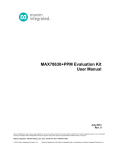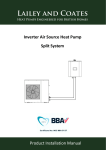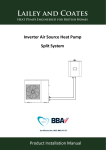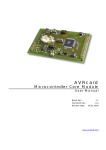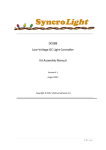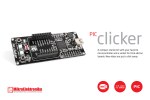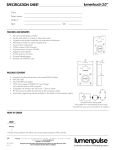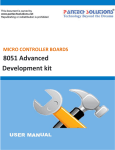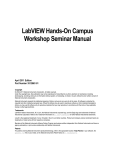Download Capstone Design Document
Transcript
Capstone Design Document Texas Integrated Energy Solutions Author: Josh Kirksey Email: [email protected] Phone: 281-813-3320 Due Date: 10/21/2009 Delivery Date: 10/21/2009 Texas Integrated Energy Solutions Table of Contents I. Problem Statement ......................................................................................... 1 II. Functional Requirements ................................................................................. 1 A. Monitoring ....................................................................................... 1 B. Selectable Parameters ...................................................................... 2 C. Other .............................................................................................. 3 III. Conceptual Block Diagram ............................................................................... 4 IV. Performance Requirements .............................................................................. 5 V. Technology Survey Assessment ....................................................................... 6 VI. Detailed Functional Block Diagram ................................................................... 8 VII. Deliverables .................................................................................................... 9 A. Functional Block Diagram ............................................................... 12 B. Functional Requirement Documentation .......................................... 12 C. Test Plan ....................................................................................... 12 D. Preliminary Schematics ................................................................... 12 E. Software Flowchart ........................................................................ 13 F. Preliminary PCB Layout .................................................................. 13 G. Final Schematic .............................................................................. 13 H. Final PCB Layout ............................................................................ 13 I. Bill of Materials .............................................................................. 14 J. Final Code Listing ........................................................................... 14 K. Test Report ................................................................................... 14 L. Cost Analysis ................................................................................. 15 M. User Manual .................................................................................. 15 N. Final Documentation ...................................................................... 15 O. Final Prototype .............................................................................. 15 VIII. Milestones .................................................................................................... 15 A. Sensor Functionality ....................................................................... 18 1. Lab environment operation ................................................... 18 2. Field environment operation ................................................. 18 CBM09 Revision 1 ii Texas Integrated Energy Solutions B. Power Subsystem Supplies Correct Power........................................ 18 C. Signals are Properly Conditioned ..................................................... 18 D. Data Processing Algorithm .............................................................. 18 E. Communication Ports ..................................................................... 19 1. RS-485 has Correct Output ................................................... 19 2. RS-232 has Correct Output and Accepts Input ....................... 19 F. Functional Lab test ......................................................................... 19 G. Functional Field test ....................................................................... 19 IX. CBM09 Gantt Chart .................................................................................................. 20 Revision 1 iii Texas Integrated Energy Solutions Problem Statement In the power transmission world, circuit breakers are used to prevent damage to equipment in the power grid. Damage caused by fault currents is what circuit breakers try to prevent. A fault current is caused by either a short to ground or by two power lines contacting each other which reduces the resistance the system sees. Both of these faults cause the current on the line to rise to unsafe levels that can damage other power transmission equipment. When a fault occurs, a circuit breaker is used to open the circuit on which the fault occurred so that customers’ and the company’s property is not damaged. Customers do lose power when the circuit breaker opens the circuit powering their section of the grid. When a circuit breaker fails to open the circuit that just experienced the fault condition, breaker failure has occurred. Breaker failure causes all protection equipment (switches and/or other circuit breakers) directly connected to the breaker to open the circuit and cut off the power being supplied to the down breaker. This can cause customers to lose power for a longer period of time, and it costs the company money. When a breaker failure occurs, it is important to quickly diagnose the problem with the breaker so that repairs can be made and power can be restored to the customer. Currently, there is no device or method that can diagnose the problem with the breaker when it fails or let the power transmission company know that breaker failure has occurred. Our solution is the CBM09. The CBM09 is designed to fit inside the cabinet of a circuit breaker, and it uses sensors attached to it to monitor the key functions of the circuit breaker. Based upon the analysis of the data collected by these sensors, the CBM09 can determine if a problem has occurred with the operation of the circuit breaker. If a problem is detected, the CBM09 will raise an alarm which can be sent to the company’s central control, indicate the problem with an LED on its case, and provide detailed information to a technician connecting to it with a laptop. Functional Requirements The functional requirements for the CBM09 have been divided into three categories: requirements for monitoring, requirements for user selectable parameters, and other requirements. Monitoring 1. Status of the trip coil: The device must measure the trip coil’s current in order to monitor the circuit breaker’s health. The device must be checking for an open or short circuit across the trip coil which would be indicated by the current. CBM09 Revision 1 1 Texas Integrated Energy Solutions 2. Trip signature (abnormal trip and slow trip): The device must monitor the trip signature for abnormal trip which is where the trip signature exceeds the limits of how big or small it can be. It must also monitor for a slow trip which is where the time required to trip exceeds the maximum time allowed by the system. 3. Re-strike: The device must monitor for re-strike which is where the fault current continues to flow through the breaker after the contacts of the circuit breaker have been separated. 4. DC ripple: The device must monitor the DC voltage being supplied to the device for an AC component on the signal. User Selectable Parameters 1. DC voltage: The device allows the user to select between 125V and 48V for the level of voltage being supplied to the device. 2. 3 or 5 cycle trip time: The device allows the user to select the maximum time allowed for slow trip to occur. 3. Sensitivity: The device allows the user to select the tolerance which is how close the actual trip signature must be to the reference trip signature. 4. Primary current : The device allows the user to trigger the end of wave capture which tells the device to stop recording the reference trip signature. 5. Record signature: CBM09 Revision 1 2 Texas Integrated Energy Solutions The device allows the user to tell the device to record the reference trip signature which captures the initial waveform of the circuit breaker. 6. DIP switches: The device must provide a switch so that the user can make a selection for each of the parameters above. Other 1. Trip signature log: The device is able to store several of the waveforms captured during the trip cycle so that someone can compare multiple waveforms to analyze the problem with the breaker. 2. PC software for accessing and viewing trip signatures: Software is required so that the user can download data captured by the device to a laptop and view it. 3. RS-485 and RS-232 communication ports: Two communication ports are needed to transmit data from the device. The RS-485 port is needed to send alarms to the control house which can relay it back to central control. The RS-232 port is needed to allow technicians to connect to the device with a laptop and get operational data on the circuit breaker. 4. Size: The device should not exceed 10” x 8” x 3” because of space constraints inside the cabinets of circuit breakers. 5. Operational temperature range: The device needs to able to function properly from -20°C to 85°C due to the operational area of the customer. CBM09 Revision 1 3 Texas Integrated Energy Solutions Conceptual Block Diagram The conceptual block diagram in Figure 1 displays a pictorial overview of the CBM09 project and a general overview of how the device operates. Sensors Measure Trip Signature in Circuit Breaker CBM09 RS-232 RS-485 to SCADA Package Processes trip signals Figure 1: Conceptual Block Diagram The CBM09 is placed inside the circuit breaker and uses sensors to measure the current across the trip coil of the circuit breaker. The current measurements are processed by a microprocessor to determine what type of fault occurred. The information about the fault is relayed to the substation control house by RS-485 communication protocol. The substation control house then relays information back to the power delivery central control. The CBM09 also allows for user interfacing using RS-232 and user input switches. The RS-232 port allows a user to interface a laptop with the device to collect a data log of trip signatures. The switches allow the user to configure the CBM09 for different types of circuit breakers in a substation. This allows the CBM09 to work universally with current as well as older circuit breakers. CBM09 Revision 1 4 Texas Integrated Energy Solutions Performance Requirements The following are the performance requirements of the various parts of the CBM09. Power Component • Step down 48V/125V DC to 12V DC to supply to voltage regulators • Voltage regulators supply correct power to other components Envelope Detector • Rectify negative voltage from current transformers to positive voltage • Create an envelope around rectified waveform and limit max voltage to 3.3 V to be used by PIC processor Signal Conditioning • Use anti-aliasing filter to filter out noise from sensor • Condition signal to be usable by PIC processor Communication • Use MAX232 device to convert UART output from PIC to RS-232 • RS-232 port allows for laptop to be interfaced with device • Data from PIC can be transferred over RS-232 to laptop • Use MAX485 to convert UART output from PIC to RS-485 • Data from PIC can be transferred over RS-485 via Distributed Network Protocol (DNP) PIC • Use algorithms to analyze data obtained from sensors in order to determine what error occurred • Produce correct output to MAX232 and MAX485 devices • Light LED corresponding to problem • Store a data log in flash memory(Erasable Electronic Programmable Read Only Memory) CBM09 Revision 1 5 Texas Integrated Energy Solutions Technology Survey Assessment The technology survey assessment is to compare and contrast different components that are important for the operation of the CBM09. These key components include a DC to DC converter, PIC microcontroller, MAX485, MAX232, and current transformers. DC to DC Converter UWR-12/250-D48 NDH4812SC NDL4809SC Pros • High efficiency • Cheaper (under $20) • Meets operating temp. requirements • High efficiency • Meets operating temp. requirements Cons • Low operating temperature range • Expensive (over $50) • Lower efficiency • More expensive (over $20) The DC to DC converters in the table above are comparing converters that accept 48V input and convert it down to 12 V output. The largest challenge in selecting the converters is to make sure that the output current is not too high. The three devices mentioned above all produce a low output current that can be accepted by voltage regulators as well as the MAX232 and MAX485 chips. Of the three devices, the best solution found was the NDL4809SC. It meets the required temperature range and had an efficiency of 83%.This was nearly 10% higher than both of the other devices. The cost was also in between the cost range of the cheapest and most expensive. The DC to DC converter used for stepping down 125 V is the HVA12. CBM09 Revision 1 6 Texas Integrated Energy Solutions PIC Microprocessor PIC24FJ32GA104 dsPIC30F4011 Pros • 2 UART channels • Large number of I/O pins • Cons • No EEPROM memory data memory 2 UART channels • Less I/O pins • EEPROM data memory • Cost more • Larger program memory The PIC24 is the cheaper option. It contains 2 UART channels for the RS-232 and RS-485 communication, and more I/O pins than the dsPIC30. However, it contains no EEPROM memory. The EEPROM memory is necessary for keeping a data log which can be erased later on. The dsPIC30 is more than double the cost of the PIC24, but it has more program memory space with the same features as the PIC24. Due to this, the dsPIC30 is a likely processor to be used in the CBM09. The MAX232DW will be used to convert UART to RS-232. The MAX485CSA+ will be used to convert UART to RS-485. Current Sense Transformers Pros Cons CR8449-1000 Smaller output voltage Measures smaller currents CR8450-1000 Measures larger currents Larger output voltage The two current sense transformer options both have different maximum currents that they can measure. The second option can measure a higher value, but produces a larger output voltage. CBM09 Revision 1 7 Texas Integrated Energy Solutions The output voltage isn’t a concern because any output voltage can easily be scalable. The second option will likely be implemented because of its ability to measure higher currents. Detailed Functional Block Diagram The functional diagram in Figure 2 shows a detailed pictorial view of the CBM09. T.I.E.S. Functional Diagram External Inputs LED Alarm Lights DC to DC Converter (12 V) 3.3 Vreg Vcc 125 V / 48 V DC Digital Output Internal Signals Vreg Vdd RS-485 UART Out MAX 485 Data Back to Control House Vdd PIC Vdd Envelope Detector Digital Input CT Sensor Envelope Detector Digital Input CT Sensor Envelope Detector Digital Input “a” Contact Sensor FUSE Trip Coil Sensor FUSE UART Out MAX 232 Allow For User Interface RS-232 Analog Input CT Sensor Vdd Vdd Anti-Aliasing Filter Signal Conditioning 3 Digital Input User Switches (Sensitivity, Cycle Time, Capture Reference) Figure 2: Functional Diagram The inputs to the CBM09 include the input voltage and the five sensors placed in the circuit breaker. The CBM09 can be powered by either 125V or 48V DC. This voltage is then stepped down to 12V, and then converted to 3.3V or another voltage to supply power to the other components of the CBM09. A 3.3V voltage regulator supplies power to the PIC. The second voltage regulator supplies voltage to the anti-aliasing filter and signal conditioning components as well as the MAX485 and MAX232. The MAX485 and MAX232 will be powered with 5V. At CBM09 Revision 1 8 Texas Integrated Energy Solutions this point in the project, the components for the signal conditioning have yet to be determined as sensors have not been determined. The anti-aliasing filter will be an active low pass filter designed with a cutoff frequency of at least half the frequency of the PICs ADC sampling frequency. Current transformers (CT) are used to monitor if current is flowing through the circuit breaker. An envelope detector is used to condition the output voltage of the CTs to be usable by the PIC processor. The envelope detector consists of a full wave rectifier, capacitor, and Zener diode. The output voltage from a CT can be positive or negative. A full wave rectifier is used to rectify the voltage to a positive output. A capacitor is used to sustain the voltage between peaks of the rectified signal. This appears as a pulsed DC signal usable by one of the PIC’s digital inputs. A Zener diode is used to cap the input voltage going into a PIC digital channel at 3.3V. If current is flowing into the transformer, a digital “one” will be read, and if no current is flowing, a digital “zero” will be read by the PIC. The “a” contact sensor and trip coil sensor have yet to be determined. There is a possibility of directly connecting to the “a” contact if a sensor solution does not work. For the trip coil, a Hall Effect sensor is one possibility. The Hall Effect sensor would monitor the current through the trip coil based on the magnetic field detected. The readings from the sensor could then be used to determine what type of abnormality occurred in the circuit breaker. The user switches are connected to the digital inputs of the PIC processor. The user can select a higher or a lower sensitivity, 3 or 5 cycle time, and capture reference with the switches. This will allow the CBM09 to be used with older or newer circuit breakers. Based on if the switch is on or off, the logic generated will be used by the PIC to determine what settings to use for the CBM09. The outputs from the PIC are digital outputs to the LED alarm lights, and the UART outputs to the MAX485 and MAX232. The LED alarm lights are used to show what type of error happened in the circuit breaker. This will allow a person to visually see what type of error occurred without the need of connecting to the RS232 interface. The MAX232 and MAX485 devices convert the UART data from the PIC into RS232 and RS485 respectively. The RS232 port will allow a user to connect to the CBM09 and obtain a data log of the errors recorded by the device. The MAX485 will send data from the CBM09 back to the substation control house via Distributed Network Protocol (DNP). Deliverables T.I.E.S. will provide items of value called deliverables to our project sponsor. Each deliverable represents valued information for team and sponsor assessment. The list in Table 1 contains the deliverables and their corresponding dates for the CBM09 project. CBM09 Revision 1 9 Texas Integrated Energy Solutions Team Member # Deliverable 1 Josh McCracken Functional Block Diagram Functional Requirement Josh McCracken Documentation Josh Kirksey Test Plan Logan Porter Preliminary Schematics Josh McCracken Software Flowchart Logan Porter Preliminary PCB Layout Logan Porter Final Schematic Logan Porter Final PCB Layout Dylan Kwan Bill of Materials Josh McCraken Final Code Listing Josh Kirksey Test Report Dylan Kwan Cost Analysis Dylan Kwan User Manual Dylan Kwan Final Documentation Josh Kirksey Final Prototype Table 1: List of Deliverables 2 3 4 5 6 7 8 9 10 11 12 13 14 15 Due Date 1/19/2010 1/19/2010 1/27/2010 2/5/2010 2/10/2010 2/12/2010 2/26/2010 3/8/2010 3/12/2010 3/31/2010 4/12/2010 4/22/2010 4/27/2010 5/10/2010 5/10/2010 The deliverables timeline is shown in Figure 3 on the next page, and it indicates the time intervals between deliverables. CBM09 Revision 1 10 Texas Integrated Energy Solutions 1/19/2010 Functional block diagram 1/19/2010 1/27/2010 Test Plan 1/19/2010 Functional Requirement Documentation 2/1/2010 2/10/2010 Software Flowchart 2/5/2010 Preliminary Schematics 2/12/2010 Preliminary PCB Layout 2/26/2010 Final Schematic 3/1/2010 3/12/2010 Bill of Materials 3/8/2010 Final PCB Layout 3/31/2010 Final Code Listing 4/1/2010 4/12/2010 Test Report 4/22/2010 Cost Analysis 4/27/2010 User Manual 5/1/2010 5/10/2010 Final Prototype 5/10/2010 Final Documentation 5/17/2010 Figure 3: Deliverables Timeline CBM09 Revision 1 11 Texas Integrated Energy Solutions Functional Block Diagram The functional block diagram will contain the technical details provided in a simplified block form. The creation of the diagram will be done with Microsoft Visio and will be converted into a PDF format for delivering. The details of the functional block diagram will include high-level hardware components such as the PIC processor, communication chips, conditioning blocks, and power conversion blocks. Internal signals and external inputs will be color coded arrows connecting various components in the CBM09. Inputs to the device are detection sensors, user selection dip switches, and input power. Outputs from the device will be the LED alarm lights and the communication ports sending information back to a control house or a data logging device. Functional Requirements Documentation T.I.E.S. will be updating and defining the scope of the project to our sponsor, Oncor. A final document created using Microsoft Word will list and clearly describe the necessary functional requirements of the CBM09. This document communicates all works which will be needed to complete the project. No other works or requirements may be added or removed from the final functional requirements document unless agreed on by both parties involved. Changes made to the document will require discussion in a conference meeting and an additional change document will be created in which the lead sponsor, team project manager, and advisor must sign-off to alter the functional requirements documentation. The document will also be a legal binding source which will be upheld in case of future discrepancies between sponsor and developing team. Test Plan The test plan will outline the tests that will be performed on individual components, subsystems, and the overall device. These will ensure that individual components work. Then after verifying individual components work, subsystems using the components are tested. These subsystems include the power and signal conditioning components, and communication component. The software will have to be tested in order to verify the data processing and communication algorithms are working. After the subsystems are tested, a lab test will be performed on the device. Once the device is tested to work in the lab setting, a fully functional test will be performed in the field at a substation site. All tests will outline what is being tested, test limits, and how a test is to be preformed. The test plan deliverable will be provided as both a hard and soft copy. Preliminary Schematics Preliminary schematics are initial drawings of the CBM09 layout. Schematics are created for the power component consisting of the DC to DC converter and voltage regulators. The signal conditioning component, consisting of envelope detector, anti-aliasing filter, and any components necessary to scale the voltage readings from the sensors used by the PIC. The PIC CBM09 Revision 1 12 Texas Integrated Energy Solutions layout including, the LED alarm lights and MAX232 and MAX485 devices. Schematics will be made using National Instruments Multisim. Schematics of each component will be created, and a block format will be used to outline the entire system to avoid cluttering. Schematics will include part names and labels of all connections. This deliverable will be delivered in a printed hard copy and softcopy in a PDF format. Software Flowchart A flow chart will be created for both the software for the CBM09 as well as the program used to download the waveforms to the technician’s computer. The charts will describe the operation of all non-library functions within each program by using Microsoft Visio shapes with inserted descriptive text. Algorithms used within any of the functions will be mentioned and fully detailed if possible. The flow charts will be created in Microsoft Visio and then will be submitted in .vsd format. Also, a hard copy will be submitted on sectionalized 8.5”x11” sheets of paper. Sections will be created based on program flow and visual appeal, and continuing sections will use page markers to indicate the preceding/proceeding page as well as connections between the sections. Preliminary PCB Layout Preliminary PCB layouts are the initial PCB layouts of the preliminary schematic designs. This includes the power component, signal conditioning, and PIC layout. PCB layouts will be made using NI Ultiboard. The layouts will show all footprints of devices, connections between components, and component labels. Scaled printouts of PCB board layers will be provided on standard 8.5” X 11” paper. Additional 1:1 scale copies of the layouts will also be provided. Gerber files and PDF versions of the PCB layouts will be delivered in soft copy format. Final Schematic The final schematics will be revisions to the preliminary schematics using NI Multisim. The final schematics will include any revisions made during testing or design review. The final schematics will be used to make the final version of the CBM09. These will be delivered in a printed hard copy and PDF soft copy. Final PCB Layout The final PCB layouts will be revisions of the initial PCB layouts. The final PCB layouts will include revisions made in the final schematic drawings. They will be the PCBs used in the finished CBM09. These will be delivered in the same manner as the preliminary PCB layouts, scaled and 1:1 hard copies with Gerber and PDF softcopy files. CBM09 Revision 1 13 Texas Integrated Energy Solutions Bill of Materials A Microsoft Excel spreadsheet will contain a list of ordered hardware components for the CBM09. Spreadsheet details will include manufacturer details, a price list, quantity number, and other necessary information to accurately describe the part ordered. The bill of materials gives Oncor, insight and the ability to comment about the parts being selected. Final Code Listing Source code will be delivered for the CBM09.This includes the user waveform capture program, non-library classes, functions, and variables. The source code will be documented and titled. Creation of a class will start with a block comment that gives the name of the class, a short description of its use, and the functions it contains. Vital class variables may include a single line comment. Likewise, the created functions will begin with a block comment containing the function name, a short description of the function, a list of the arguments, the argument types, and the return value. As with classes, important variables will be commented. Single line comments will also be inserted for important steps within a function. C and C++ source files will include a header file for each source file. Both the header and the source files will include a block comment at the beginning with authoring information. Header information will include the name of the company that owns the software (T.I.E.S.), the date the file was created, the last modification date, a list of contributing authors, and an operational summary of the code. For the CBM09’s software components and the user waveform capture program the following format will be used for categorizing the folders: project implementation, source files, header files, support documentation, and additional includes. The project implementation folder will contain the Visual Studio and MPLab files. The additional includes folder will contain the libraries of precompiled code used in the project. Due to the length and nature of source code, the developed source code for the CBM09 and user waveform capture program will be submitted in softcopy format and, upon request, in hardcopy format. The submission will also include a list of software and hardware required for the code to function and will be included in the softcopy submission if possible. Test Report The test report will contain the results for every test performed in the test plan including component, subsystem, and fully functional tests. The results will contain any data necessary in order to justify the tests. These include measurements, graphs, tables, etc. Any errors found in the tests will also be noted in the test report. The report will be delivered in soft copy PDF format as well as a hard copy printout. CBM09 Revision 1 14 Texas Integrated Energy Solutions Cost Analysis Cost analysis for the CBM09 can be described as a financial breakdown of labor hours, workspace, hardware parts, software design suites, packaging, test equipment, and printed media. Analysis for these items include: direct and indirect costs, other costs, profit, and total project costs. The costs analysis report will be continually updated throughout the life of the project and will be handed to Oncor as a Microsoft Excel spreadsheet in both hard and soft copy. User Manual A user manual of the CBM09 includes a setup guide for Oncor substation technicians to safely and successfully mount the CBM09 into the circuit breaker’s control panel. The manual also includes information regarding the device’s operational characteristics, GUI interface, and troubleshooting tips. Final Documentation The final documentation will be given to Oncor upon completion of the CBM09. The document will contain a compilation and comprehensive summary of all project information. The project summary, description of CBM09 components, an explanation of all tests performed and their respective results, submitted deliverables, project timelines, software code, relevant component data sheets, PCB schematics, PCB layouts, cost analysis, and user installation guide/manual will be included. The final documentation will have enough information on the CBM09 to allow recreation of the device. This deliverable will be submitted in both hard and soft copy format using Microsoft Word for document generation. Final Prototype The final prototype will be handed alongside the final documentation. The prototype will be a fully functional system which meets the criteria provided by the functional requirement document. The device provided will include the physical unit in its own enclosure and supporting GUI software for data logging. Milestones Milestones will be scheduled demonstrations to our sponsor, Oncor. Each milestone will be a validation of our device’s functionality and will be an indicator of progress. T.I.E.S. has scheduled a series of milestones with sub-categories in a select few demonstrations. Demonstrations may be confirmed through our sponsor’s participation or through video with approval from the advisor. A total of seven milestones will be demonstrated to Oncor. T.I.E.S. has listed the following milestones in Table 2 for the current project. CBM09 Revision 1 15 Texas Integrated Energy Solutions # Milestone 1 2 Sensor Measurements in Lab Sensor Measurements in Field Power Subsystem Supplies Correct Power Signals are Properly Conditioned Data Processing Algorithm RS-485 has Correct Output RS-232 has Correct Output and Accepts Input Functional Lab Test Functional Field Test Table 2: List of Milestones 3 4 5 6 7 8 9 Demonstration Date 1/26/2010 2/2/2010 2/9/2010 3/16/2010 3/23/2010 3/29/2010 3/29/2010 4/20/2010 4/30/2010 The milestones timeline is shown in Figure 4 on the next page which indicates the time intervals between milestones. CBM09 Revision 1 16 Texas Integrated Energy Solutions 1/19/2010 1/26/2010 Sensors Demo in Lab 2/1/2010 2/2/2010 Sensors Demo in Field 2/9/2010 Power Subsystem Demo 3/1/2010 3/16/2010 Demo Signal Conditioning 3/23/2010 Demo Data Processing Algorithm 4/1/2010 3/29/2010 Demo RS-232 & RS-485 4/20/2010 Demo CBM09 in Lab 5/1/2010 4/30/2010 Demo CBM09 in Field 5/10/2010 Figure 4: Milestones Timeline CBM09 Revision 1 17 Texas Integrated Energy Solutions Sensor Functionality The first milestone is sensor functionality. Sensor functionality will show the capabilities of the sensors in both lab and field environments. Each demonstration is important because the sensors are vital in detecting abnormalities within the circuit breaker. Sensor Measurements in Lab Oncor will provide us a circuit breaker for lab testing. T.I.E.S. will demonstrate that the current transformer sensors will accurately track current flowing through their circuit breaker. Other sensor demonstrations include the trip coil sensor tracking current through the trip coil and the “a” contact sensor telling the status of the “a” contact. This demonstration will be done on January 26, 2010. Sensor Measurements in Field Once the sensors have been demonstrated in the lab, the following week, T.I.E.S. will have a demonstration of the sensors out in the field. The sensors will be shown to work at the substation with heavy EMI presence. This demonstration will be done on February 2, 2010. Correct Power Supplied The second milestone will validate the board’s power subsystem correctly stepping down the input voltage in order to successfully power the hardware components without damaging them. Further step downs include 3.3 V for the PIC microcontroller and 5V to the communication chips as well as to different anti-aliasing and amplification subsystems. This demonstration will be done on February 9, 2010. Signals Properly Conditioned The third milestone will confirm the ability of the anti-aliasing and amplification subsystem to convert analog signals into acceptable digital inputs for the microcontroller to process. Signals from the current transformer are converted into digital inputs that stop at 3.3V. Trip coil and “a” contact sensors will have their noise in the signal removed to represent their true current and voltage readings. This demonstration will be shown on March 16, 2009. Data Processing Algorithm The data processing algorithm will be the next milestone, and it will have a majority of the signal processing algorithms being demonstrated. The demonstrations will include its ability to sample waveforms frequently and regularly to detect critical points in the waveform. These critical points include: first current peak, corner point, and maximum current peak. The data processing algorithm will also graphically show a captured waveform, detect if re-strike has occurred, and CBM09 Revision 1 18 Texas Integrated Energy Solutions be able to detect if the DC ripple is too high. Lastly, the algorithm will tell if non-continuity exists across the trip coil. This demonstration will be shown on March 23, 2009. Communication Ports Communicating information from the CBM09 back to the substation control house will be a critical milestone because information must be relayed in a real-time fashion. This will help benefit Oncor’s technicians in understanding and quickly acting upon the data being delivered to them. RS-485 Port has Correct Output The RS-485 port will demonstrate the ability to send data using DNP (Distributed Network Protocol) and reliably send the data to a control outhouse in the substation. This demonstration will be shown on March 29, 2009. RS-232 Port has correct Output and Accepts Input The RS-232 port will demonstrate the ability to send data to a peripheral device used for data logging. Technicians logging data will also be able to access the microcontroller’s memory to download recorded history banks of trip waveforms. This demonstration will be shown on March 29, 2009. Functional Lab Test The functional field test will include the full system demonstration on the test circuit breaker. All functional requirements must be met in regards to the functional requirements document. This test will be the second to last milestone and will be shown on March 20, 2009. Functional Field Test This milestone will mark the end of demonstrations and provide a fully functional prototype that is able to work in the lab as well as in the field with EMI. All functions of the device must be demonstrated and meet the criteria of the functional requirements document. Final demonstration will be shown on April 30, 2009. Gantt Chart A Gantt chart is used to illustrate when each phase of the project will be worked on. The Gantt chart in Figure 5 on the next page shows our current plan for completing each phase. CBM09 Revision 1 19 Texas Integrated Energy Solutions Start Finish Duration 12/20 12/27 1 Research 12/15/2009 2 Design 3 Implementation 4 Apr 2010 Mar 2010 Feb 2010 Jan 2010 Dec 2009 Task Name ID 1/20/2010 27d 12/22/2009 3/8/2010 55d 1/22/2010 3/31/2010 49d Testing 1/26/2010 4/30/2010 69d 5 Procurement 1/22/2010 3/19/2010 41d 6 Wrap Up 4/12/2010 5/10/2010 21d 1/3 1/10 1/17 1/24 1/31 2/7 2/14 2/21 2/28 3/7 3/14 3/21 3/28 4/4 4/11 4/18 4/25 5/2 Figure 5: Gantt Chart CBM09 Revision 1 20























